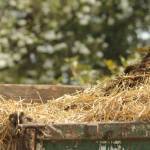Influence of Equine Management on Ammonia Emissions

Across the globe, the number of animals producing manure, naturally rich in ammonia, continues to increase, which translates directly into increases in ammonia. Ammonia gas reacts with sulfuric acid and nitric acid in the air to form small particles that have negative health and environmental effects. Of importance, those small particles aggravate respiratory diseases in horses. Additionally, ammonia and its secondary products contribute to soil acidification eutrophication and disruption of ecosystem functions.
“Understanding ammonia (NH3) emissions from different sources, quantifying their magnitudes, and evaluating mitigation options are the subject of scientific research, worldwide,” explained a group of researchers from China, where livestock populations are growing rapidly.
Based on that research group’s estimates*, ammonia levels in 2008 were 7.3 Tg NH3/year (note: 1 Tg = 1,012 grams). If no changes occur in the way ammonia is managed, by 2030 ammonia levels are anticipated to essentially double, reaching 13.9 Tg NH3/year. Potential ways to mitigate ammonia production suggested by the researchers include:
- Shifting from high- to low-protein diets that still meet the animals’ needs. Lowering crude protein in diets for various animal categories can decrease manure pH and the nitrogen content of animal excreta, which will then decrease nitrogen emissions For example, nitrogen emissions decrease by 10% when crude protein is reduced by 1%.
- Adopting low emission housing by reducing the surface area polluted by manure and reducing indoor air exchange rates and temperatures to the extent minimal animal production and welfare allow.
- Covering stored manure to reduce the exposure of stored manure to air; however, this conserves nitrogen in manure and can result in increase of nitrogen emissions during manure field application.
- Using low-ammonia application strategies that minimize surface exposure of manure when being spread (e.g., injection or direct incorporation of manure into soil).
Based on the study’s findings, the authors concluded that by using these strategies projected ammonia emissions could be reduced by 18.9–37.3% compared to the emissions projected for the year 2030.
“Researchers all over the world are making great strides in decreasing ammonia produced by livestock. Ultimately, anywhere horses live, urine and feces will be found and even the ammonia produced by a single horse can be hazardous to respiratory health,” warned Kathleen Crandell, Ph.D., a nutritionist for Kentucky Equine Research (KER).
She added, “In addition to environmental, management and pharmaceutical strategies for maintaining equine respiratory health, dietary supplementation with omega-3 fatty acids containing both EPA and DHA also helps horses suffering from heaves.”
KER offers EO•3, a palatable, potent marine-derived oil rich in both DHA and EPA that is easily top-dressed onto feed.
*Xu, P, S. Koloutsou-Vakakis, M.J. Rood, et al. 2017. Projections of NH3 emissions from manure generated by livestock production in China to 2030 under six mitigation scenarios. The Science of the Total Environment. 607-608:78-86.








